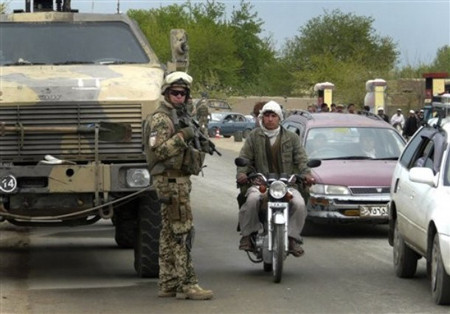The New York Times, May 8, 2010
Shootings of Afghans on Rise at Checkpoints
Since last summer, none of the Afghans killed or wounded in convoy and checkpoint shootings had weapons that would have posed a danger for troops who killed them, commanders said
By Richard A. Oppel Jr.
Shootings of Afghan civilians by American and NATO convoys and at military checkpoints have spiked sharply this year, becoming the leading cause of combined civilian deaths and injuries at the hands of Western forces, American officials say.

At least 28 Afghans have been killed and 43 wounded in convoy and checkpoint shootings this year — 42 percent of total civilian deaths and injuries and the largest overall source of casualties at the hands of American and NATO troops, according to statistics kept by the military. (Photo: AP)
The steep rise in these convoy and checkpoint attacks — which the military calls “escalation of force incidents” — has prompted military commanders to issue new troop guidelines in recent weeks that include soliciting local Afghan village and tribal elders and other leaders for help preventing convoy and checkpoint shootings.
These shootings are a major reason civilian casualties in Afghanistan are soaring after a much-publicized period of decline.
Such episodes “have taken the lead” in civilian casualties caused by Western forces, said Lt. Gen. David Rodriguez, the day-to-day operational commander of American and NATO forces in Afghanistan. “We’ve really got to figure out how to solve that problem, and it’s really a challenge to the leadership. It’s a challenge to discipline.”
Civilian deaths from aerial bombings have declined, General Rodriguez said. But in convoys and at checkpoints, “you’re faced with a different challenge of snap decisions” by troops “much closer to not only the people but the enemy.”
At least 28 Afghans have been killed and 43 wounded in convoy and checkpoint shootings this year — 42 percent of total civilian deaths and injuries and the largest overall source of casualties at the hands of American and NATO troops, according to statistics kept by the military.
In the same period last year, 8 Afghans were killed and 29 wounded in similar episodes. For all of 2009, 36 Afghan civilians were killed in the so-called escalation of force incidents by Western and Afghan troops, according to the United Nations. Over all, the Taliban and other militants account for a much larger number of civilian casualties than Western forces do, the United Nations found.
Since last summer, none of the Afghans killed or wounded in convoy and checkpoint shootings had weapons that would have posed a danger for troops who killed them, commanders said.
The new military guidelines instruct troops to “tailor” procedures to the local environment by consulting local Afghan leaders, and whenever possible, to remain at the scene of convoy shootings and take responsibility for their actions.
The guidelines also instruct commanders to coach troops to not “automatically take the easy safe route when doing so requires the use of standoff weapons or indirect fire,” and to practice drills “that include decisions to disengage, as well as decisions to engage.” Troops are also told to construct checkpoints more carefully to give more space to maneuver and potentially avoid shooting at vehicles perceived as threatening.
Teams are being sent to stress the new rules to ground units. General Rodriguez’s senior enlisted counterpart, Command Sgt. Maj. Darrin J. Bohn, said teams were emphasizing that procedures that made sense in one area would not necessarily work in others, and that local commanders should come up with whatever worked best in their areas.
Ninety Afghan civilians were killed by American and NATO troops during the first four months of the year — almost two and a half times the number during the same period last year — while 100 others were wounded. The deadliest episode occurred in February when 27 civilians who were mistaken for Taliban fighters were killed by American attack helicopters.
That has abruptly reversed the downward trend that, according to United Nations researchers, began last year after Gen. Stanley A. McChrystal, the overall commander of American and NATO forces, put in place measures to reduce civilian casualties.
Some of the increase can be explained by heightened military operations, but the rise in civilian deaths this year has outpaced the increase in the number of Western troops.
The shootings inflame Afghans, who see them as proof that Western forces operate with impunity. President Hamid Karzai has been harshly critical of civilian deaths caused by the American military, saying they jeopardize any progress that the military offensive might be making.
Even in thanking American troops during a trip to Bagram Air Base on Saturday, Mr. Karzai again called for caution in their operations, although more obliquely. “When you’re out in the fields in Afghanistan alongside Afghan soldiers, it is like any other society,” The Associated Press reported Mr. Karzai as saying. “There are families. There are children. There are women. There are elderly people. There are young people and people who are ill. I’m sure that you take appropriate and good care of the situation when you face it.”
Mr. Karzai is to meet with American officials in Washington beginning Monday.
A recent military-commissioned survey of almost 2,000 residents of Kandahar Province found that American and NATO convoys were perceived as equally as dangerous as roadside bombs and more dangerous than Taliban checkpoints.
While underscoring how much civilian shootings are damaging the American and NATO campaign, commanders also emphasize the need for troops to defend themselves.
“The last thing you want to do is put people, because of the pressure or the guidance, into positions where they are losing their lives because they don’t think they have the right of self-defense,” General Rodriguez said.
Characters Count: 6804
